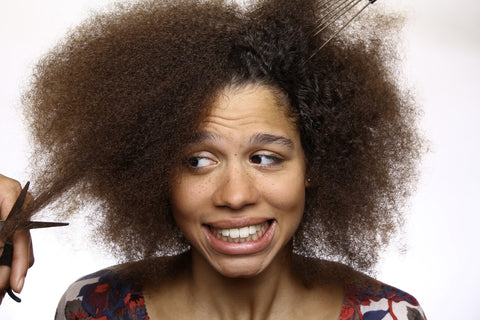
Experiencing tangles, breakage, and hair that doesn’t look its best? It might be time for a trim. Trimming is essential to healthy natural hair and length retention. Here’s why:
- Split ends naturally start developing a couple months after every trim. Split ends are caused by natural wear and tear on your hair, and while you can prevent split ends from occurring as quickly, it is impossible to completely eliminate them. When you don’t trim split ends, they continue to split all the way up the hair shaft. This results in the loss of the entire strand, rather than just the end.
- Split ends and single strand knots catch and snag more easily on each other, increasing tangles.
- Tangles are enough of a problem on their own, but they also increase breakage, especially if you don’t detangle gently. To prevent tangles and resulting breakage, it's essential to trim off split ends and single strand knots.
- Split ends also make your hair (particularly your ends) look scraggly, frizzy, and unhealthy. Your hair will look its best when you trim it regularly.

Why don't we trim our hair as often as we should?
Most stylists recommend that you trim your hair once every 3-4 months, depending on the health of your hair. If you treat your hair exceedingly well you might not accumulate split ends for 6-8 months. But most of us don’t trim our hair as often as we should. Does this sound like you? It's probably for one of these two reasons:
1. Trimming your hair feels like losing length. You probably think, "the longer I go without trimming my hair, the longer my hair will be," right? Not exactly. Trims do remove a small amount of your length, but let’s do the math. In optimal conditions your hair growth about half an inch a month, so in 4 months your hair can grow about 2 inches. If you keep your hair healthy, a trim will remove less than ¼ to ½ an inch, leaving with you with most of your growth.
But if you don’t stay on top of trims and split ends, they will spread up the hair shaft and you’ll need to take off more length when you finally do trim your hair. Additionally, your split ends will lead to breakage in the meantime, reducing your length even more. For example, if you double the time between trims to 8 months, your hair will grow 4 inches- but you could lose 2 inches or more to breakage and split ends, as opposed to two small trims of ¼ inch each in those 8 months. So you retain more length when you trim your hair regularly.
2. We’re lazy. Sorry, did we call you out? It's okay, we feel it too! It's just the truth. Setting up 4 haircuts a year takes time and effort. Not to mention, haircuts can be expensive! That’s why NaturAll is bringing you tips on how to trim your hair yourself.

Trimming your hair can be intimidating if you’ve never done it before, but there are so many benefits. It takes less time. You don’t have to leave your house. You are completely in control of how much length you take off (we’ve all had a hair stylist take off way more than we asked for!) And once you have the right tools, it’s free! You can quickly save hundreds of dollars in your first couple years of trimming your own hair.
How to trim your own natural curly hair
- Only cut your hair with professional hair shears. Really sharp scissors like these are non-negotiable; in fact, if you aren’t willing to get a pair, you’re better off not trimming your hair at all. Any other scissors will leave a jagged end that is far more prone to splitting in the future. Do NOT use your office or kitchen scissors on your hair, under any circumstances!
- Once you have hair shears, don’t use them for anything besides your hair. Otherwise they will grow dull, which defeats the purpose of getting hair shears.
- Cut dry. Some people cut hair wet because wet hair is more stretched, so it is easier to see and make a clean cut. However, your hair is also weakest when it is wet, so trimming wet can lead to more breakage and damage. If you're reading this blog we are guessing you are not a professional- so we recommend playing it safe and cutting your hair dry.
- Cut carefully. We have provided a range of common methods below for cutting natural hair and some are easier than others, but any of them can go wrong if you rush or don’t focus. Give yourself plenty of time, especially the first time you do it.

DIY Hair trimming methods
- Two-strand twists: When you twist your hair, notice the frizzy, dry, coarse ends at the very bottom of your twists? You can go twist by twist and snip those off, leaving soft, clean ends. This is a great method for those with shorter hair. The smaller you make your twists, the more accurate your cut will be!
- Curl by curl: As opposed to twisting your hair, let your hair fall in clumped curls. Then go curl by curl, trimming off the scraggly ends. This method is recommend for those with looser curls (type 3A - 3C.)
- “Search and destroy”: You can also leave your hair down and carefully look through your ends for split ends and single strand knots, snipping them off when you find them. Warning: this method is time consuming, and will leave you with hairs of slightly different lengths since you won’t cut every hair.
- Blowout: To provide the most visibility for a clean, even cut, use medium heat to stretch your hair before you trim. This method is time consuming as well because it involves doing a full blowout, and you’ll need to be careful to not damage your hair with heat.
Give one of these methods a try and skip the hair salon! And now that your ends are healthy again, use NaturAll's Fresh Frozé Treatment Deep Conditioners to reduce split ends from now on!













